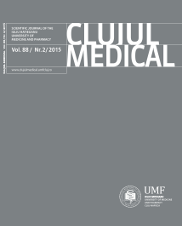Photodynamic therapy of melanoma using new, synthetic porphyrins and phthalocyanines as photosensitisers - a comparative study
DOI:
https://doi.org/10.15386/cjmed-419Keywords:
melanoma, photodyamic therapy, porphyrins, phthalocyanines, cell photokillingAbstract
Melanoma, a cancer that arises from melanocytes, is one of the most unresponsive cancers to known therapies and has a tendency to produce early metastases. Several studies showed encouraging results of the efficacy of photodynamic therapy (PDT) in melanoma, in different experimental settings in vitro and in vivo,as well as several clinical reports.Aims. Our study focuses on testing the antimelanoma efficacy of several new, synthetic photosensitisers (PS), from two different chemical classes, respectively four porphyrins and six phthalocyanines.
Methods. These PS were tested in terms of cell toxicity and phototoxicity against a radial growth phase melanoma cell line (WM35), in vitro. Cells were exposed to different concentrations of the PS for 24h, washed, then irradiatied with red light (630 nm) 75 mJ/cm2 for the porphyrins and 1 J/cm2 for the phthalocyanins. Viability was measured using the MTS method.
Results. Two of the synthetic porphyrins, TTP and THNP, were active photosensitizers against WM35 melanoma in vitro. Phthalocyanines were effective in producing a dose dependent PDT-induced decrease in viability in a dose-dependent manner. The most efficient was Indium (III) Phthalocyanine chloride, a metal substituted phthalocyanine.
Conclusions. The most efficient photosensitizers for PDT in melanoma cells were the phthalocyanines in terms of tumor cell photokilling and decreased dark toxicity.
Downloads
Additional Files
Published
How to Cite
Issue
Section
License
The authors are required to transfer the copyright of the published paper to the journal. This is done by agreeing to sign the Copyright Assignment Form. Whenever the case, authors are also required to send permissions to reproduce material (such as illustrations) from the copyright holder.

The papers published in the journal are licensed under a Creative Commons Attribution-NonCommercial-NoDerivatives 4.0 International License.

